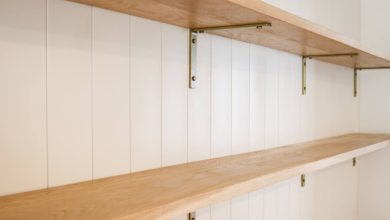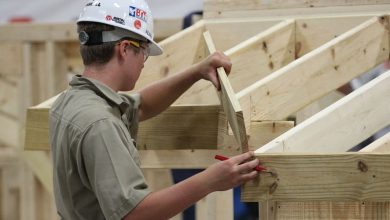What Is Ppe in Carpentry
PPE, which stands for personal protective equipment, is essential for carpenters.
Carpentry work comes with inherent risks that can lead to common injuries.
To mitigate these risks, carpenters should use PPE to protect themselves.
This includes head protection with a compliant hard hat, eye protection, and hearing protection.
It is important to choose high-quality PPE that meets safety standards, such as appropriate hearing protection with a Signal to Noise Ratio value.
Additionally, respiratory protection is necessary to prevent health risks associated with wood dust, cement, and asbestos.
Protective gloves should also be worn, and there are different types available for specific tasks.
Foot protection with safety shoes is important as well.
Employers have a responsibility to provide PPE free of charge, and it is crucial to maintain it in good condition.
Various other types of PPE, including fall arrest systems for working at heights, are also required in carpentry.
Proper fit, comfort, and communication in confined spaces are important considerations.
Finally, managing heat stress, UV protection, and wearing suitable clothing for protection against hazards are essential aspects of using PPE in carpentry.
Did You Know?
1. PPE stands for Personal Protective Equipment in carpentry, and includes various safety gear such as goggles, gloves, hard hats, and ear protection.
2. Did you know that some carpenters wear specialized PPE called Kevlar gloves? These gloves are made of a strong synthetic fiber that provides excellent protection against cuts and punctures.
3. When it comes to eye protection, there are different types of goggles commonly used in carpentry. Safety goggles are designed to shield the eyes from debris and dust, while welding goggles offer protection against intense light and sparks generated during welding or grinding tasks.
4. Besides the usual safety gear, carpenters who work with loud power tools or in noisy environments often wear earmuffs or earplugs as part of their PPE. These help protect their hearing from long-term damage caused by excessive noise exposure.
5. One interesting piece of PPE used in carpentry is an apron with multiple pockets. Carpenters often wear this type of apron to keep essential tools handy and within easy reach, making their work more efficient.
Risks Associated With Carpentry Work
Carpentry work is a rewarding and fulfilling profession that allows individuals to showcase their skills and creativity. However, it also comes with its fair share of risks. Carpenters are exposed to various hazards on a daily basis, including falls, cuts, and strains. These risks can result in severe injuries, permanent disabilities, or even death if proper precautions are not taken.
Working with power tools and machinery poses a significant risk to carpenters. Accidental contact with these tools can cause serious injuries, such as cuts, lacerations, and amputations. Carpenters must also be mindful of the potential health risks associated with exposure to chemicals, such as solvents and glues. Prolonged exposure without proper protection can lead to respiratory problems, skin irritations, and even potentially fatal conditions.
Another often overlooked hazard in carpentry work is working at heights. Whether it be constructing scaffolding or working on a roof, a fall from even a relatively low height can lead to severe injuries. Carpenters must be diligent in using fall arrest systems and training provided to them to prevent such incidents.
Head Protection With A Compliant Hard Hat
In the world of carpentry, head protection is of utmost importance. Carpenters can be susceptible to head injuries due to falling objects, slipping or tripping hazards, and accidental impacts. To mitigate these risks, carpenters should always wear a compliant hard hat.
A compliant hard hat is specifically designed to provide protection against impacts and penetration. It consists of a rigid shell made of high-density polyethylene and a suspension system to absorb and distribute the force of impact. The shell is capable of withstanding falling objects and repelling sharp objects, ensuring the carpenter’s safety.
Wearing a hard hat not only protects carpenters from potential head injuries but also complies with safety regulations and legal obligations. It is essential for both carpenters and their employers to prioritize head protection to create a safe working environment.
- Head protection is vital in carpentry.
- Risks include falling objects, slipping hazards, and accidental impacts.
- A compliant hard hat provides protection against impacts and penetration.
- Made of high-density polyethylene, the rigid shell can withstand falling objects and repel sharp objects.
- Wearing a hard hat complies with safety regulations and legal obligations.
- Prioritizing head protection creates a safe working environment.
Eye Protection For Carpenters
Carpentry work involves various tasks that pose risks to the eyes. Carpenters are frequently exposed to dust, flying debris, and particles that can cause eye injuries or lead to long-term damage. It is crucial for carpenters to wear appropriate eye protection to safeguard their vision.
Safety glasses or goggles should be worn during carpentry tasks that generate dust, such as cutting, sanding, and drilling. These protective eyewear options are designed to prevent particles from entering the eyes while providing a comfortable fit. They have impact-resistant lenses that can withstand flying objects and debris.
Additionally, safety glasses with side shields can provide extra protection from peripheral hazards, such as fragments or sparks. It is important to note that regular prescription glasses do not offer the same level of protection and should not be considered as a substitute for safety eyewear.
Carpenters should prioritize eye protection by wearing suitable safety glasses or goggles at all times, reducing the risk of eye injuries and ensuring long-term visual health.
Check this out:
Frequently Asked Questions
What PPE is used in carpentry?
In carpentry, workers utilize various types of personal protective equipment (PPE) to ensure their safety. This typically involves using safety boots for foot protection, gloves to protect the hands, goggles to shield the eyes from potential hazards, ear protection to prevent hearing damage, and high-visibility clothing to enhance visibility on the worksite. It is crucial to note that the selection of PPE should be appropriate for the specific tasks and related hazards, as emphasized by Solomon.
What does PPE mean in woodworking?
PPE stands for Personal Protective Equipment in woodworking. It refers to the gear and clothing worn by operators to minimize the risk of injuries or exposure to hazardous materials. In this context, PPE includes protective eyewear to shield the eyes from flying particles and chemicals, ensuring the safety and well-being of woodworking professionals.
What is PPE used for in construction?
PPE in construction plays a crucial role in safeguarding workers from various risks associated with the industry. It serves as a shield against physical violence, offering protection through essential equipment like helmets and body armor. Additionally, construction PPE includes specialized clothing or uniforms that mitigate specific health and safety hazards, such as high-visibility clothing worn by emergency service personnel. By adhering to the requirements of PPE in construction, workers can work more confidently and securely, enhancing overall safety on construction sites.
What PPE is required when working with wood finishes?
When working with wood finishes, it is essential to prioritize the safety of operators by ensuring they are equipped with appropriate personal protective equipment (PPE). Operators working downstream of the objects being sprayed inside the booth should be provided with an air-supplying respirator to safeguard against any potential inhalation hazards. Additionally, dip-coat operators should be equipped with gloves, boots, aprons, and jackets, sleeves, or coats to protect them from possible splashes of the wood finishes, enhancing their overall safety during the process.

